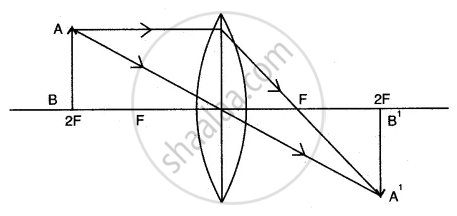Advertisements
Advertisements
Question
An object is placed in front of a convex lens such that the image formed has the same size as that of the object. Draw a ray diagram to illustrate this.
Solution

APPEARS IN
RELATED QUESTIONS
If an object is at a considerable distance (or infinity) in front of a convex lens, where is the image formed?
You eye contains a convex lens. Why is it unwise to look at the sun?
Find the nature, position and magnification of the images formed by a convex lens of focal length 0.20 m if the object is placed at a distance of:
0.25 m
A convex lens forms an image of an object equal to the size of the object. Draw a diagram to illustrate it.
A student places a 8.0 cm tall object perpendicular to the principal axis of a convex lens of focal length 20 cm. The distance of the object from the lens is 30 cm. He obtains a sharp image of the object on a screen placed on the other side of the lens. What will be the nature (inverted, erect, magnified, diminished) of the image he obtains on a screen? Draw ray diagram to justify your answer.
List four properties of the image formed by a convex mirror.
Where must a point source of light be placed in front of a convex lens so as to obtain a parallel beam of light?
If an object is placed in front of a convex lens beyond 2F1, then what will be the position, relative size, and nature of an image which is formed? Explain with a ray diagram.
What is the difference between a double convex and a bi-convex lens?
State the nature and position of the object on the principal axis to obtain a virtual and magnified image.
